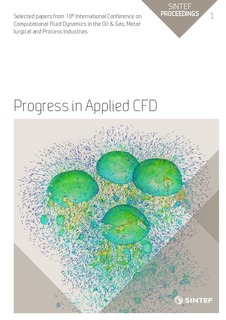| dc.contributor.author | Ramirez Lopez, Pavel Ernesto | |
| dc.contributor.author | Jalali, Pooria Nazem | |
| dc.contributor.author | Sjöström, Ulf | |
| dc.contributor.author | Nilsson, Christer | |
| dc.date.accessioned | 2017-11-08T08:14:40Z | |
| dc.date.available | 2017-11-08T08:14:40Z | |
| dc.date.issued | 2015 | |
| dc.identifier.isbn | 978-82-536-1432-8 | |
| dc.identifier.isbn | 978-82-536-1433-5 | |
| dc.identifier.issn | 2387-4295 | |
| dc.identifier.uri | http://hdl.handle.net/11250/2464786 | |
| dc.description.abstract | An advanced numerical model able to predict transiently the multiphase flow, heat transfer and solidification in a Continuous Casting mould based on the Volume of Fluid Method (VOF) in combination with the tracking of bubble trajectories during argon injection through a Discrete Phase Model (DPM) is presented. This methodology allows studying the effect of Argon injection on process stability; particularly, it investigates the influence of the bubble stream on steel/slag flow dynamics. Thus, different injection parameters such as bubble diameter and gas flow-rate were combined with specific casting practices to emulate industrial cases. As a result, the model makes possible the identification of stable or unstable flows within the mould under a variety of casting conditions (casting speed, nozzle submergence depth, etc.). Application to the industrial practice in a European Research Fund for Coal and Steel project is an ongoing task and preliminary results are illustrated. These results are fully applicable to explain the effect of gas injection on the behaviour of mould level fluctuations in the mould. Moreover, the predicted flow behaviour and bubble trajectories demonstrate good agreement with observed level changes, standing waves and gas departure positions observed on a physical model based on liquid metal and industrial observations. Ultimately, the increased process knowledge is used to optimize gas injection to provide a smooth distribution along the mould that benefits process stability. The robustness of the model combined with physical model observations make possible the description of phenomena difficult to observe in the caster, but critical for its performance and the quality of final products. | nb_NO |
| dc.description.sponsorship | ACKNOWLEDGEMENTS. PRL would like to thank operators at SSAB for fruitful discussions, Mr. Christer Olofsson for support during CCS-1 trials and Mrs. Pilvi Oksman at Aalto University for proof-reading the manuscript. PJ would like to thank Professor Pär Jonsson at KTH, Stockholm for continuing support during his M.Sc. and Doctoral studies. The research leading to these results has received funding from the European Union's Research Programme of the Research Fund for Coal and Steel (RFCS) under grant agreement n° [RFSR-CT-2011-00005] | nb_NO |
| dc.language.iso | eng | nb_NO |
| dc.publisher | SINTEF Academic Press | nb_NO |
| dc.relation.ispartof | Selected papers from 10th International Conference on Computational Fluid Dynamics in the Oil & Gas, Metallurgical and Process Industries | |
| dc.relation.ispartofseries | SINTEF Proceedings;1 | |
| dc.subject | Bubble dynamics | nb_NO |
| dc.subject | Argon injection | nb_NO |
| dc.subject | Discrete Phase Modelling | nb_NO |
| dc.subject | Volume of Fluid | nb_NO |
| dc.subject | Multiphase | nb_NO |
| dc.subject | Casting and solidification | nb_NO |
| dc.title | Modelling argon injection in continuous casting of steel by the DPM+VOF technique | nb_NO |
| dc.type | Chapter | nb_NO |
| dc.type | Conference object | nb_NO |
| dc.type | Peer reviewed | |
| dc.description.version | publishedVersion | nb_NO |
| dc.rights.holder | © 2015 SINTEF Academic Press | nb_NO |
| dc.subject.nsi | VDP::Technology: 500 | nb_NO |
